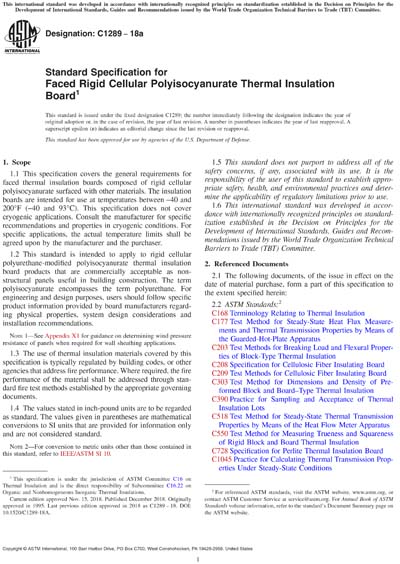Historical
ASTM C1289-18a
Standard Specification for Faced Rigid Cellular Polyisocyanurate Thermal Insulation Board
1.1 This specification covers the general requirements for faced thermal insulation boards composed of rigid cellular polyisocyanurate surfaced with other materials. The insulation boards are intended for use at temperatures between −40 and 200°F (−40 and 93°C). This specification does not cover cryogenic applications. Consult the manufacturer for specific recommendations and properties in cryogenic conditions. For specific applications, the actual temperature limits shall be agreed upon by the manufacturer and the purchaser.
1.2 This standard is intended to apply to rigid cellular polyurethane-modified polyisocyanurate thermal insulation board products that are commercially acceptable as non-structural panels useful in building construction. The term polyisocyanurate encompasses the term polyurethane. For engineering and design purposes, users should follow specific product information provided by board manufacturers regarding physical properties, system design considerations and installation recommendations.
Note 1: See Appendix X1 for guidance on determining wind pressure resistance of panels when required for wall sheathing applications.
1.3 The use of thermal insulation materials covered by this specification is typically regulated by building codes, or other agencies that address fire performance. Where required, the fire performance of the material shall be addressed through standard fire test methods established by the appropriate governing documents.
1.4 The values stated in inch-pound units are to be regarded as standard. The values given in parentheses are mathematical conversions to SI units that are provided for information only and are not considered standard.
Note 2: For conversion to metric units other than those contained in this standard, refer to IEEE/ASTM SI 10.
1.5 This standard does not purport to address all of the safety concerns, if any, associated with its use. It is the responsibility of the user of this standard to establish appropriate safety, health, and environmental practices and determine the applicability of regulatory limitations prior to use.
1.6 This international standard was developed in accordance with internationally recognized principles on standardization established in the Decision on Principles for the Development of International Standards, Guides and Recommendations issued by the World Trade Organization Technical Barriers to Trade (TBT) Committee.
Content Provider
ASTM International [astm]






